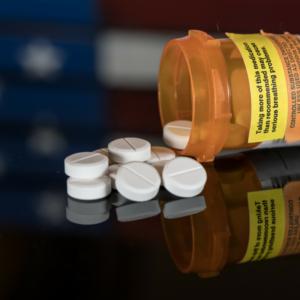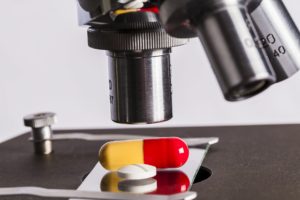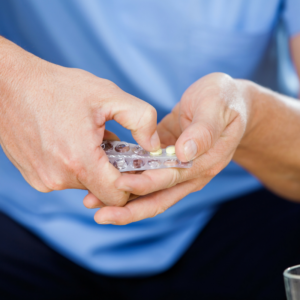by Lucia Mueller, President, PharmacyChecker.com | Jun 8, 2018 | Drug Safety
 Costs of products that improve women’s sex lives by treating a dry vagina, a taboo yet common condition, are on the rise here in the U.S. It’s bad enough to face the unfair stigma of needing medication that has anything to do with your vagina, but Big Pharma has decided to make that experience even more difficult. American women deserve to know that those much-needed products are sold at international online pharmacies for a fraction of the price tag at their local pharmacy.
Costs of products that improve women’s sex lives by treating a dry vagina, a taboo yet common condition, are on the rise here in the U.S. It’s bad enough to face the unfair stigma of needing medication that has anything to do with your vagina, but Big Pharma has decided to make that experience even more difficult. American women deserve to know that those much-needed products are sold at international online pharmacies for a fraction of the price tag at their local pharmacy.
The New York Times’ Katie Thomas recently published an article, Prices Keep Rising for Drugs Treating Painful Sex in Women, that highlighted this quiet conversation in the corner of the drug prices crisis. Your EpiPens and asthma inhalers are perhaps easier to gripe loudly about than meds related to personal matters. “It’s just infuriating that the price has gone up and up and up for no good reason,” said Cynthia Pearson, the executive director of the National Women’s Health Network, who expressed frustration at the lack of attention due to the stigma.
Women have seen prices on drugs, such as Estrace cream and Estring, more than double in the last five years. The article goes on to report that one woman “has resorted to ordering her drug from overseas at a cost of about $80 for a three-month supply,” which is great news for that savvy lady, but unfortunately leaves the reader hanging on how to safely order their own medication from abroad. After all, shopping for medications online can be quite treacherous: the internet is a landmine of scammers and sellers of counterfeit medication. Peer-reviewed and independent research demonstrates that when consumers use PharmacyChecker-verified pharmacies to buy medications purchased online, they receive lawfully-manufactured, high-quality medication. Not to mention those meds are typically sold at a much lower price than available at local U.S. pharmacies.
Vagifem sold in the U.S., mentioned in the article, is actually manufactured in Denmark. At U.S. pharmacies, just 8 tablets of Vagifem 10 mcg can cost women around $200, but it’s sold at international online pharmacies for as low as $20, a 90% savings. Premarin Vaginal Cream is a whopping 98% cheaper if women order through an online pharmacy in the United Kingdom that’s been verified by PharmacyChecker. Premarin sold in the U.S. is manufactured in Canada.
Vagina may be a stigmatized word, but saving money on meds? Now, that’s something to shout about.
Tagged with: dry vagina, estrace, estradiol
by Dr. Shivam Patel, PharmD, BSPS, RPh, Director of Pharmacy Verification and Information | Mar 19, 2018 | Drug Safety
 Dear PharmacyCheckers,
Dear PharmacyCheckers,
I have seen, first-hand, the impact on patients due to rising medication costs. As a former community pharmacist in Massachusetts, my patients wouldn’t hesitate in expressing their shock at outrageous costs. I’d often hear a “Why do my meds cost so much?!” or “I’m certain I paid less for this last month.” Sadly, there wasn’t much I could do to help these patients. Some would reluctantly break their budgets to continue on with their drug therapy, while a heartbreaking majority would assure me they would be back with the money… and never return.
I am joining PharmacyChecker because it is my hope that I can lessen the number of these stressful situations for patients. I desire for patients to focus on getting better and staying healthy instead of worrying about how they will afford their medications. Throughout my pharmacy career, patient safety has always been the primary focus, and I relish the opportunity to bring that focus to PharmacyChecker. (more…)
Tagged with: Dr. Shivam Patel, pharmacist
by Gabriel Levitt, President, PharmacyChecker.com and Prescription Justice | Mar 9, 2018 | Drug Safety
 According to a new study, it turns out that, potentially, millions of people should have been prescribed over-the-counter drugs—not addictive narcotics. That’s a major finding considering 600,0000 Americans have died from drug overdose between 1999-2016. The Journal of the American Medical Association (JAMA) study shows that over-the-counter medications, such as ibuprofen, acetaminophen, aspirin and naproxen may work better than the hard, addictive stuff, such as Vicodin, Oxycontin, and Fentanyl.
According to a new study, it turns out that, potentially, millions of people should have been prescribed over-the-counter drugs—not addictive narcotics. That’s a major finding considering 600,0000 Americans have died from drug overdose between 1999-2016. The Journal of the American Medical Association (JAMA) study shows that over-the-counter medications, such as ibuprofen, acetaminophen, aspirin and naproxen may work better than the hard, addictive stuff, such as Vicodin, Oxycontin, and Fentanyl.
We recognize and respect the role that properly prescribed prescription narcotics have played and will continue to play in pain management. However, we also believe that Big Pharma makers and sellers of opioids caused this national crisis of drug addiction by helping to create looser prescribing rules. In other words, while at one-time opioid medications were viewed as a last resort to treat serious pain, drug companies pushed medical education that led to the prescribing of opioid drugs. The U.S. Centers for Disease Control and Prevention has revised its guidelines to encourage far tighter prescribing practices, but, as this study indicates, their revisions came way too late.
Patients Who Took Opioids
The JAMA study looked at 248 patients with varying levels of pain, back pain being the most prevalent form affecting 65% of patients. Others had pain associated with hip, knee and that associated with osteoarthritis. One group of patients were prescribed opioid medications. They started with fast acting morphine, a combination of hydrocodone and acetaminophen, or oxycodone. Long acting medications, morphine or oxycodone, were used when the short acting treatments were not working. When those did not work, fentanyl patches were prescribed.
Patients Who Took Non-opioids
Another group took NSAIDs. If NSAIDs did not work, then the group took other prescription medications, such as gabapentin (Neurontin) or pregabalin (Lyrica). If those didn’t work, then tramadol, which is an opioid-based painkiller but less addictive than the ones in the opioid group.
Results of the Study
Patients in the non-opioid group reported equal or better results in pain alleviation than patients in the opioid group. Admittedly, I’m confused because tramadol was in the non-opioid group, even though it’s an opiate-based medication. Also, one shortcoming variable of the study is that patients knew what medications they were taking, which could have biased their reporting.
Overall, the study strongly demonstrates that millions who were prescribed strong opioid drugs and became hooked could just as well have been treated initially with regular OTC pain medications. Not surprisingly, patients could have also saved billions of dollars over the last few decades by taking aspirin instead of brand-name prescription opioids.
This has really caught my attention because the industry-funded groups like the Alliance for Safe Online Pharmacies and Partnership for Safe Medicines equates importation from Canada with the opioid crisis. Instead of urging people to seek alternatives to opioids, the pharmaceutical industry propagates the senseless idea that increasing imports of lower cost (non-pain) medications from Canada will worsen the opioid crisis. They would rather point fingers than address the sickness of their complicity in creating the drug addiction crisis in the first place.
Tagged with: Alliance for Safe Online Pharmacies, CDC, JAMA, NSAIDs, opioids, OTC, Partnership for Safe Medicines
by Gabriel Levitt, President, PharmacyChecker.com and Prescription Justice | Jan 18, 2018 | Drug Safety

FDA Testing Lower-Cost Imported Medications
Tens of millions of people have bought medications from foreign pharmacies – despite the technical illegality of importing those medications. According to reporting by Kaiser Health News last month, the FDA tested imported medications, apparently to see if what Americans are doing is safe. All medications the FDA tested “contain[ed] the ingredients matching the medicines ordered.”
The Kaiser Health News reporting was focused on international pharmacy options offered by local governments, schools, and other self-insured organizations. While that’s interesting, it’s not breaking news (I mentioned it here). The FDA testing imports and saying the medications are safe, albeit begrudgingly, is breaking news. (more…)
Tagged with: drug imports, FDA, public education, testing, transparency
by Lucia Mueller, President, PharmacyChecker.com | Nov 30, 2017 | Drug Safety
 The verdict is in: blister packs may be a safer bet for packaging your medication. In the U.S. and sometimes in Canada, however, medications are dispensed as loose pills.
The verdict is in: blister packs may be a safer bet for packaging your medication. In the U.S. and sometimes in Canada, however, medications are dispensed as loose pills.
According to the FDA, over 1.3 million people are injured each year due to medication mistakes, which include dispensing errors in U.S. hospitals and pharmacies. As discussed in a blogpost by Roger Bate, an economist at the American Enterprise Institute, it may be safer to receive your medications in blister packs, whether dispensed locally or from an international pharmacy by mail, and the FDA seems to agree.
(more…)
Tagged with: Blister Packs, FDA, Roger Bate
by Gabriel Levitt, President, PharmacyChecker.com and Prescription Justice | Aug 31, 2017 | Drug Safety
 By way of the craftiest of PR snakes, pharmaceutical companies infest the media, politicians, and consumers with the idea that if we expressly permit people to buy lower-cost medications from other countries, we break the “closed” pharmaceutical distribution system. This concept of a “closed” system is sadly overplayed and misleading.
By way of the craftiest of PR snakes, pharmaceutical companies infest the media, politicians, and consumers with the idea that if we expressly permit people to buy lower-cost medications from other countries, we break the “closed” pharmaceutical distribution system. This concept of a “closed” system is sadly overplayed and misleading.
The U.S. Food and Drug Administration (FDA) is one of the leading drug regulatory authorities, but as the pharmaceutical industry continues its propagandistic efforts against legalizing importation of lower-cost medication, the myth making has got to be called out. You’ll have to forgive me for the lengthy post: I’ve chosen to include long quotes from experts—perhaps to offset my frustrated tone—but mostly to properly inform you what we’re up against.
The fact is, you can trust the safety and efficacy of medications sold in the U.S., but NOT more so than Canada or many other countries. People are not paying attention to the perpetual lies Big Pharma regurgitates on this issue. In a follow-up post, I’m going to discuss myriad ways that the FDA is doing a much better job, but, for the moment, excuse me while I blow off sufficient “What-the-hell-is-going-on?!” steam. (more…)
Tagged with: closed, coukell, drug distribution, FDA inspections, GAO
 Costs of products that improve women’s sex lives by treating a dry vagina, a taboo yet common condition, are on the rise here in the U.S. It’s bad enough to face the unfair stigma of needing medication that has anything to do with your vagina, but Big Pharma has decided to make that experience even more difficult. American women deserve to know that those much-needed products are sold at international online pharmacies for a fraction of the price tag at their local pharmacy.
Costs of products that improve women’s sex lives by treating a dry vagina, a taboo yet common condition, are on the rise here in the U.S. It’s bad enough to face the unfair stigma of needing medication that has anything to do with your vagina, but Big Pharma has decided to make that experience even more difficult. American women deserve to know that those much-needed products are sold at international online pharmacies for a fraction of the price tag at their local pharmacy.






